 |
 |
 |
http://www.varalaaru.com A Monthly Web Magazine for South Asian History [184 Issues] [1822 Articles] |
 |
 |
 |
http://www.varalaaru.com A Monthly Web Magazine for South Asian History [184 Issues] [1822 Articles] |
|
Issue No. 96
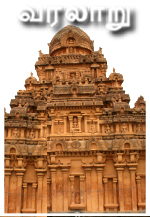
இதழ் 96 [ ஜூன் 2013 ] 
இந்த இதழில்.. In this Issue.. 
|
Series:
Pudukkottai Cave Temples
(Continuing...) The Sathyagiriswara rock cut cave consists of a facade, a rectangular mukhamandapa and a sanctum. The sanctum is excavated on the western wall of the mandapa; while the mandapa is facing south, the sanctum is facing east. 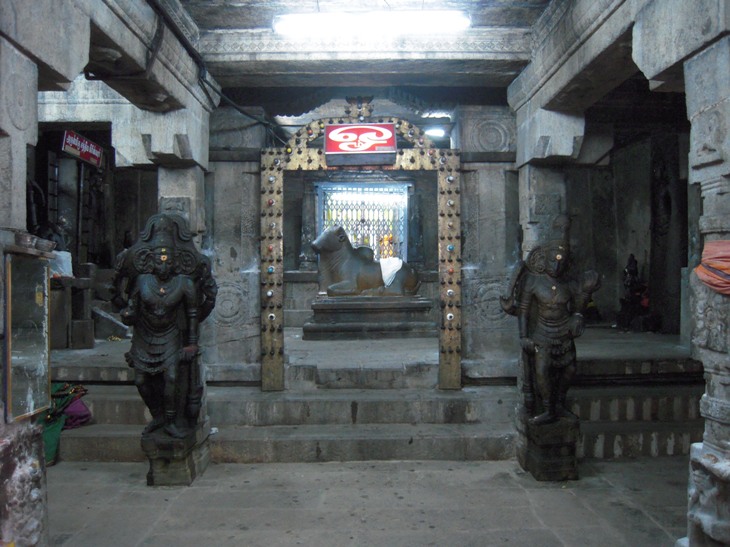 THE ROCK CUT CAVE The facade is 7.41mts in the east-west and .68mts in the north-south directions. It has an adhishthana which is partly visible with the features of rudra kumuda, kantha with pada flanked by kampa on both sides and pattika.8 The rock cut mandapa is .72mts from the front mandapa floor and the stone blocks arranged as steps veil not only the adhishthana of the facade but also the inscription in the kantha portion. The facade consists of two colossal pillars in the middle and pilaster on both ends with the features of square, octagonal kattu and square. The widths of the anganas range between 1.86mts - 1.90mts. The facade has the side wall extension of 1.14mts on the east and 1.06 mts on the west, where inscriptions are engraved on it. The rough rock brow forms the kapota, which is veiled by the roof of the mandapa. The canopy of the kapota is flat. The rear pillars of the front mandapa partially hide the frontage of the rock-cut cave. Dvarapalas are plastered in these pillars facing south. Comparing the upper square the lower square and kattu are long. Faces of both the upper and the lower squares are adorned with circular medallions inscribed inside a square frame. It is interesting to note that variety of flower patterns are handled in the medallions.9 The medallions in the eastern pillar and pilaster are ornamented with lotus flowers with two to four whorls. In some faces a blossom of two whorls are shown in which the inner as closed and outer as bloomed. The northern face of the eastern pillar possess lotus medallion with four whorls. The western pillar and pilaster are decked with medallion of lilly buds. Some faces are adorned with five half bloomed flowers encircling inside a square frame, whereas some possess eight half bloomed flowers and also interweaved with buds. The pilasters possess only half frame of the medallions. Above the pillars and pilasters rest the potikas, which are slender with taranga in the edges and patta in the center. Three wavy arches are formed in the base and five in the angular section. The potikas bears the uttira and a thin vajana is running adjoining the roof. The central band in the potikas possess scroll with leaf pattern in it.10 A flight of two steps leads to the south facing mukhamandapa.11 The pattika extend as the floor of the mandapa. The mandapa measures 4.19mts in north-south and 8.37mts in east-west directions. The sanctum is formed on the western lateral wall facing east, a huge bas-relief lingodhbava occupy the eastern lateral wall and the northern wall is sectioned as three divisions by cantoning pilasters. In the center of the mandapa is seen a rock cut Nandi facing the presiding deity. Traces of stucco finishing and paintings are visible in the mandapa roof.12 Both in the facade and also in the northern wall of the mandapa, the corner pilasters are shown protruding out of the side walls. On the eastern side both in the facade and in the hind the wall extends .44mts and .38mts respectively. As like on the western side it extends .12mts13 in the facade and .47mts in the hind wall. Four pilasters are cantoning the northern wall of the mandapa. As like the facade the pilasters are formed on a raised floor to a height of .04mts from the mandapa and .02mts inside on the raised floor. Besides, the pilasters possess same features as like the pillars and pilasters of the facade. The southern faces of the pilasters possess medallions in which the middle pilasters are adorned with full medallions whereas the corners are half frames. As like the facade pilasters the corner pilasters of the northern wall also protrude from the side wall of the mandapa. The space formed between the pilasters is 2.16mts in the east and 1.97mts in the west. Both in the western and the middle spaces platforms are built in the front to place sculptures. The potikas are taranga and bears the uttira. The vajana is running through out the mandapa buffering the roof and the uttira and the downward extension in the corners are absent. The middle space is enclosed by iron-grill where bronze sculptures of Nataraja with his consort to his left and Appar to his right are kept. Sculptures are found scattered in the mandapa. Ganesa and Muruga are placed on either side of the sanctum entrance in the platform adjoining the sanctum wall. Ganesa, Bhairava and a saint are seen on the platform in the north-west. Sanisvara, Bhairava are seen near the lingodhbava. 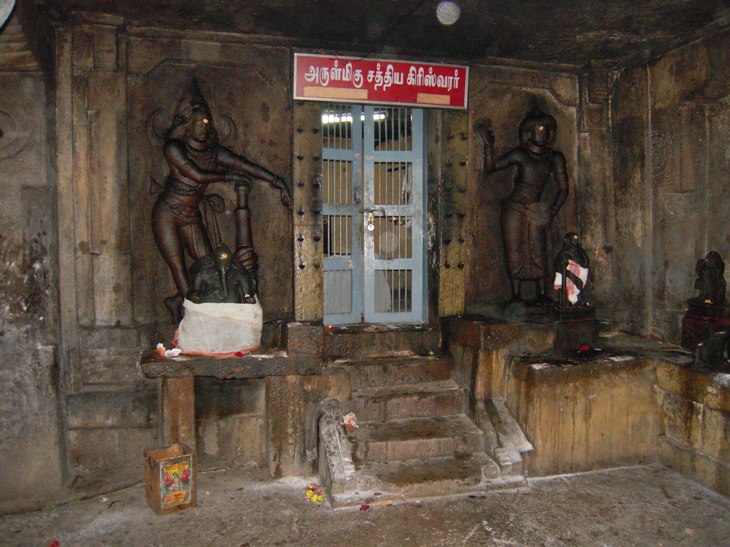 SANCTUM The sanctum is little higher in level from the mandapa floor. The west wall forms the fore wall of the sanctum which is sectioned as adhishthana, bhitti and prastara. The adhishthana is padabandha with the features of upana, jagati, rudra kumuda, kantha flanked by kampa on both side and pattika.14 Later additions veil the adhishthana fully on the northern side and partially in the south. Above the pattika raises the wall cantoned by four pilasters. The corner pilasters are three faced, while the middle two are slit pilasters. The pilasters are sectioned as square, octagonal kattu, square in which the kattu is a long shaft. The potikas are angular and taranga with the middle wave forming a contour scroll on the face of the potikas.15 The corner potikas are three limbed; one extending towards the niche, one towards the mandapa and the outer limb for both the pilasters are small extension.16 The faces of the squares are adorned with flower medallions inside a square frame. The middle pilasters are covered by metal plates. An aperture to a height of 2mts and .89mts breadth is formed between the middle pilasters as entrance to the sanctum. The space between the pilasters on either side of the entrance is formed as niche. The potikas holds the uttira and a thin vajana buffer the roof and the uttira. The niche on the south is adorned by Tirisular and the same on the north is adorned by Maluvadiyar. The sanctum is reached by a flight of five steps in which only the lower three are rock cut and flanked by rock cut parapet wall. The lowermost step it parted as two layers; lower strata as rectangular frame and above it the chandrakal is shown. As like in the parapet wall the inner layer is formed as undulated trunk with scroll tip. The sanctum is a cubical room with the rock cut linga in the center. It is 3.88mts in east-west and 3.92mts in north-south direction. The height of the sanctum is 2.27mts. The sanctum houses linga in which the circular avudaiyar is formed with padabandha features such as jagati, rudra kumuda, kantha flanked by kampa on both sides, pattika and upari kampa. Both the avudaiyar and the bana are .65mts respectively. A small gomukha is shown towards north bear by a squatted lion. The lion is seated on the kampa with its hind limbs rested on the kumuda and the fore limbs placed on a small rock cut pedestal that formed adjoining the jagati and kumuda, and it bears the gomukha on its head. On the roof of the inner mandapa adjoining the mother rock a dravida shikara is shown for the rock cut shrine. 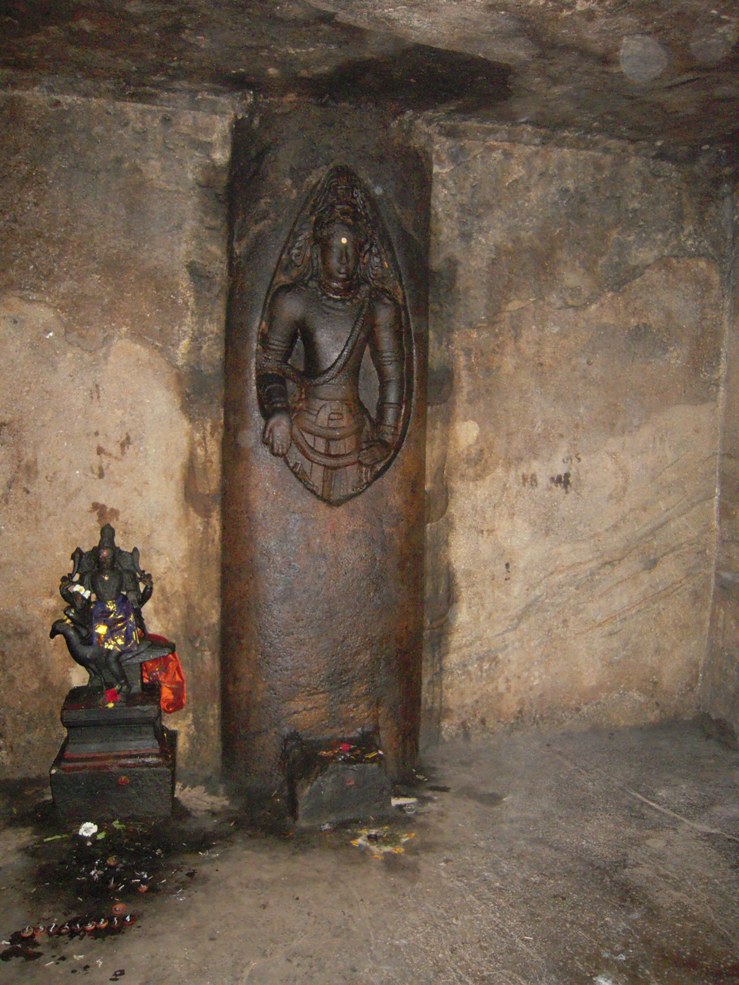 LINGODHBAVA The bas-relief Lingodhbava extending to the roof and floor of the mandapa is cut in the centre of the eastern wall. The rudra bana is .90mts width and .26mts extending inside the mandapa. A slit is shown in the middle of the bana where Lord Siva emerges in anthropomorphic form. He is shown upto his waist standing inside the bana with his locks arranged as jatamakuta and the untied locks are beautifully curled in the edges. Earlobes are elongated and decked with makarakundala in the right and snake kundala in the left. His ornaments are stone studded and he is adorned with charapali, udarabandha, armlets and bangles. A garland is worn as yajnopavita in niveta fashion. His lower garment is fastened around his waist with the stone studded hip belt, the excess girdle flows in the front. He is wearing idaikattu above the lower garment. His left hand is on the thigh and the right hand is in varada. Fire flames at equal intervals are shown on either side of the bana. A small square shaped rock cut balitala to a height of .23mts is seen at the foot of the bana. 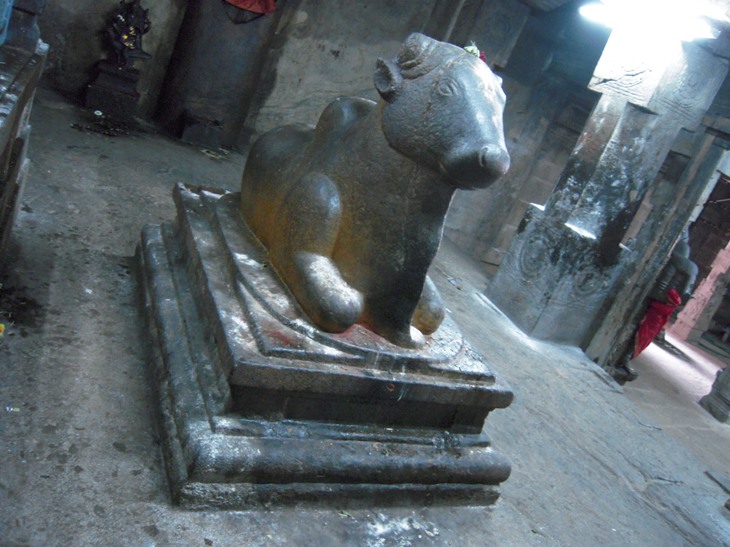 NANDI In the middle of the mandapa is seen a seated nandi on a platform facing the sanctum. The entire structure is rock-cut and it elevates to a height of 1.51mts from the ground. The platform is 1.61mts in the east-west and 1.15mts in the north-south directions and to a height of 0.55mts. It is shown as a padabandha adhishthana17 in which the uparikambu is shown in two layers, the lower stratum as oblong and above it elliptical. A chubby nandi with heavy dew lap and hump is seen seated slightly leaning its body to its right. 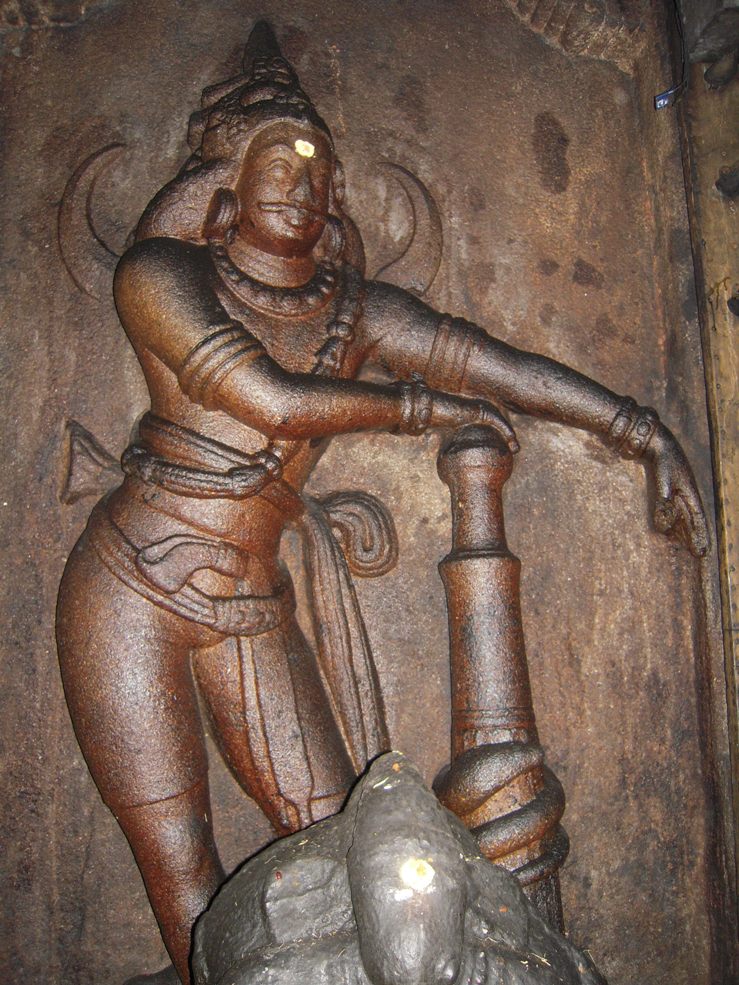 TIRISULAR Tirisular in the southern niche is standing slightly orienting towards the sanctum with his right leg in tryasra and his left leg forming swastika behind his right leg and placed in agratalacanchara. His head decorated as karantamakuta18 with headgear and the free floating hair forming a thick jatabhara behind him. A short attire is tightly tucked around his waist and thigh and secured by a hip belt. The girdle that run around the waist is formed as a single bow knot in the centre and dangle on the left thigh. Vastra is worn around the abdomen as udarabandha to which a heavy knot is formed to his left and its long end dangle upto to his knee whereas the short end float behind him. The vastra yajnopavita is coupled with flower clasps and worn in upavita fashion.19 His ornaments are heavy and stone studded; ears are adorned with patrakundalas, Charapali and bangles are stone studded, upper arms are adorned with coiled armlets. The ornament in the waist is with heavy clasp at the centre. He is wearing a ring in the small finger. Trident is shown behind him in which the outer forks raise above his shoulder and the middle fork extend above his makuta.20 A heavy mace is placed to his left held by his right hand and the left hand is stretched over it.21 The mace is pointed at the tip and knobbed at the top with trimmed handle and the shaft has fluted finishing. A snake is shown entwining the mace. Thick mustaches, wide opened eyes with raised eyebrows, heavy ornaments and a slight grin are much imposing. 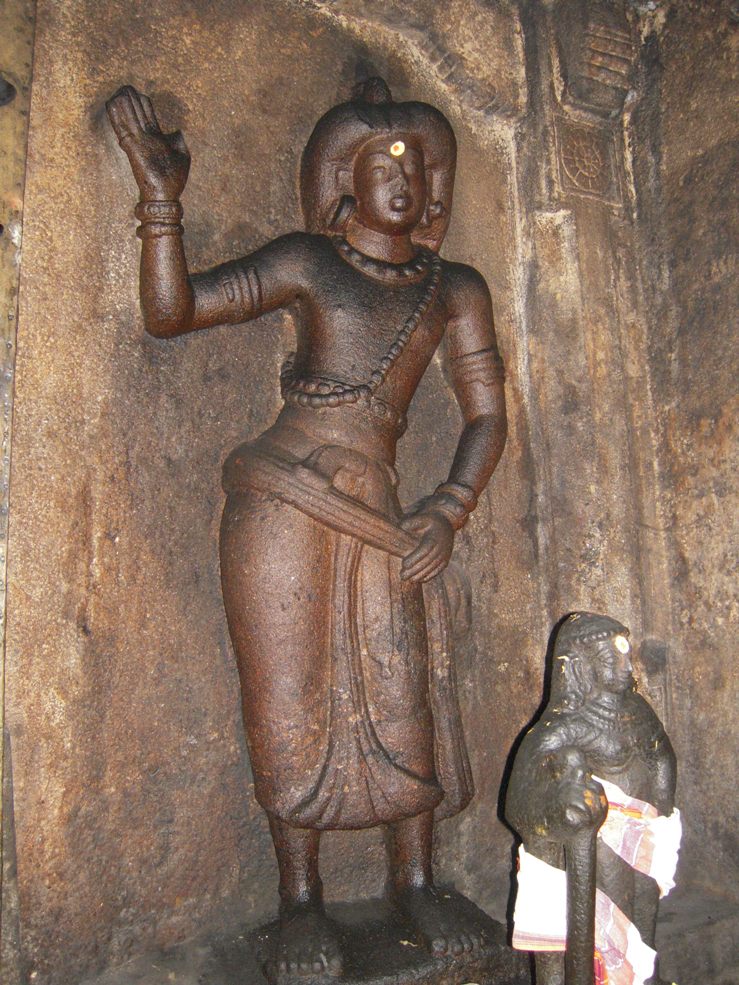 MAZHUVADIYAR The Mazhuvadiyar22, 23 in the northern niche is standing on a small rock cut platform formed above the pattika with both his legs in tryasra. His head is decorated as jatabhara which is formed as a thick pad parted in the middle and the machete is shown in the center. His lower garment is draping upto the calf which is gathered at the centre and tucked under the hip belt.24 The excess noose of the hip belt is formed a single bow knot at the clasp and dangled on his left thigh. The idaikattu is slackly worn above the lower garment for which heavy knot is formed on the left. His left hand is placed on the thigh holding the idaikattu in which the small finger is adorned with a ring whereas the right hand is raised up adoring25 the God. A string of big beads is worn as yajnopavita in upavita fashion and the charapali, udarabandha, bangles are stone studded. The upper arm is decked with coiled armlet. Patrakundala adorns his right ear whereas the left ear is elongated and a small kundala is fitted in it.26 Comparing his counterpart, Mazhuvadiyar is young and has boyish look. Lot of small things are handled to infuse soul in this sculpture. His slender figure, standing with his legs apart, body leaned to his left, head tilted right and slightly stooping down with yielding eyes all add poise and composure to his boyish look. The anthropomorphic depiction of the weapons of the presiding deity as door keepers are also seen at the rock cut shrines of Kundrandarkoil, Malayadipatti Siva and Vishnu caves. Both the dvarapalas of Sathyagiriswara cave are splendid and magnificent.  INSCRIPTIONS There are nine inscriptions copied in this temple complex.27 The earliest known inscription of the temple complex is the grantha inscription found on the northern wall of the rock cut mandapa that mentions the musical instrument 'Parivadini-da'.28 Below the grantha term 'Parivadini-da' a much defaced Tamil inscription which belong to the same period is also seen.29 The 7th regnal year inscription of Sundarapandya30, 31 corresponding to the year A.D. 1245 speaks about the settlement of dispute in various points between the Saivites and the Vaishnavites in the presence of the Hoysala chief Appanna Dandanayaka. One of the noted settlements is the partition of the temple complex between Thirumeyyathu Mahadevar and Thirumeyyathu Nindraruliya devar. It is clearly laid out that the wall is to be constructed two feet to the west of the western wall of the mukhamandapa of the Pallikondaruliya Azhalwar. The thickness of the wall is given as 1 cubit of the Thachchanmuzhankol and the construction cost to bear by both the parties. The inscriptions elaborately mention the layout of the wall and also periphery of both the temple complexes. It is understood from the inscription that both the temples have their own pond. Besides, the inscription also speak about the partition of commonly owned lands between Mahadevar and Nindraruliya devar, share in the procured paddy, also list out the land belonging to the Mahadevar and Nindraruliyathevar, appointment and payment for the percussionists etc. Another noted aspect of the inscription is that it lay out that this partition was between the Mahadevar and Nindraruliya devar and not Pallikondaruliya Azhalwar. The 8th regnal year inscription of Sundarapandya32 speaks about streamlining of the cash endowment made by Iranji Udaiyan, one of the chieftains of Rajaraja chola which was utilized for Masimagam festival. But during the above said period a land was purchased for the same money and taxes were volunteered by the assembly. The land was kept under four Bharatvajas and in return they have to pay 30 kalam of paddy to the temple. The 11th regnal year inscription of Sundarapandya33 found on the southern precipice of the mother rock near the 7th regnal year inscription bring to limelight the deceit of one Thiruvengadanambi Senthamarai Kannan on land allocation for the Mahadevar temple percussionists, to be done as per the 7th regnal year settlement inscription. The matter was brought under the Assembly of Thirumeyyam and finally resolved. The inscription refers the 7th regnal year inscription under the epithet 'Vaishnavamaheshwaram'. Four of the inscriptions found in the temple complex are much defaced. The 19th regnal year inscription of Rajaraja I34 speaks about Thirumeyyam as a Devadana Brahmadeya under Kananadu in Arumozhideva Valanadu. It also mentions the Lord of the temple as 'Sri Mulasthanamudaiya Mahadevar'. The 21st regnal year inscription of Rajendra I35 speaks about cash endowment for offering to the Thirumeyyathu Devar. It also refers a coin in the name 'Rajendra Chola Madai' in usage. An inscription36 in 13th century paleography in poetry style speaks in praise of a mercantile community. It is incomplete and also much inhumed under the construction. Another much defaced inscription37 belongs to Parakrama Pandya speaks about procurement of paddy from various villages as per convention. 7. IPS 340, 472. 8. Discovered by Dr. R.Kalaikkovan, Director, M.Rasamanikanar Centre for Historical Research, Thiruchirappalli. 9. ibid., Soundarrajan, K.V., சு.இராசவேலு, அ.கி.சேஷாத்திரி, ஜெ.ராஜாமுகமது didn't mention about the medallions in the pillars, pilasters of both the facade, northern wall. 10. The other only cave in the district with ornamental median band is Sittannavasal rock cut cave. 11. ibid., ஜெ.ராஜாமுகமது., 'புதுக்கோட்டை குடைவரைகளுள் பகுதியில் உயரமான மண்டபம் கொண்டது இக்குடைவரை ஆகும்'. P.182. If the author is meaning the inner height of the mandapa there are also other examples with equally huge mandapas in the same district viz., Sathyamoorthy rock-cut cave, Kundrandarkoil, Pathinenbhumivinnagaram. 12. ibid., ஜெ.ராஜாமுகமது., 'இக்குடைவரை முழுவதும் சுதையால் பூசப்பட்டு வண்ணம் தீட்டப்பட்டிருந்தது தெரிய வருகிறது. இவையெல்லாம் பிற்காலத்தில் சுரண்டி எடுக்கப்பட்டது போலும்'. P.183 13. In this corner the upana, jagadi, kumudha components of the sanctum wall reaches upto the pilaster of the facade, hence the side wall extension starts on kumudha. 14. ibid., Soundarrajan, K.V., சு.இராசவேலு, அ.கி.சேஷாத்திரி, ஜெ.ராஜாமுகமது, didn't mention the adhishthana. 15. This feature is absent in both the facade and the hind wall pillars and pilasters. 16. Sittannavasal also possess three limbed potikas in the sanctum anterior wall, but all the limbs are fully formed. 17. Components are jagadi, rudra kumuda, gala complex, pattika and uparikambu. 18. Soundarrajan, K.V., Rock-cut Temple Styles – Early Pandya Art and the Ellora Shrines, Somaiya Publications Pvt. Ltd., Mumbai. 'karanta type of jatamakuta'. P.102. 19. ibid., Soundarrajan, K.V., " an yajnopavita is running around his waist over an udarabandha which is knotted ஸ.." P.102. Yajnopavita is running over the udarabandha but not around the waist. 20. Soundarrajan, K.V., Rock-cut Temple Styles – Early Pandya Art and the Ellora Shrines, ஸtwo cusped horns emerging out of his shoulders around his head, suggesting that he is the manifestation of Nandi bull. P.102. ibid., சு.இராசவேலு, அ.கி.சேஷாத்திரி, இவரது தலையில் கரண்டமகுடமுடன் கூடிய சடைமுடியும் தோளின் இருபக்கங்களிலும் கொம்புகள் போன்றும் காட்டப்பட்டுள்ளது. இது இவரை நந்தியின் வடிவமாக காட்டுகிறது'. P.187. But he is the Trident, the middle fork is seen behind his head. 21. ibid., சு.இராசவேலு, அ.கி.சேஷாத்திரி, "...கைகளில் ஒன்றை தடி மீது பிடித்தவாறு காட்சியளிக்கின்றது". P.187. 22. ibid., Soundarajan, K.V., "young ascetic" . P.102 23. Srinivasan, K.R., Temples of South India, National Book Trust, India, 1972, according to the author, one of the dvarapala flanking the shrine entrance of Thirumeyyam, Kundrandarkoil and Thevarmalai, a portrait sculpture of a king or chieftain, also found at Veerasigamani. P.57. 24. Same style of dressing is also seen at Kundranadarkoil, the mazhuvadiyar shown in the northern niche. 25. ibid., Soundarajan, K.V., his right arm raised in vismaya. P.102 சு.இராசவேலு, அ.கி.சேஷாத்திரி, கை ஒன்றை விஸ்மயம் முத்திரை காட்டி நிற்கின்றார்'. It is wrong, the right hand adores the God in the sanctum and the left hand is on the thigh. P.187 26. ibid., Soundarajan, K.V., patrakundala in both ears is wrong. P.102 27. Five are published in IPS., Inscription Nos.5, 340, 341, 467, 472. Besides these the SII Vol.22 published 391, 392, 384A. One discovered by Dr. M.Rasamanikkanar Centre for Historical Research. 28. IPS. 5. This grantha inscription in same script and style also found at Malayakkoil, Kudumiyanmalai and Thirumeyyam Upper rock cut caves. On the basis of this inscription the four of the rock cut caves can be brought under same period. Besides, the grantha inscription also repulse the age of the Sathyagiriswara rock cut cave earlier to Pallikondaruliya Azhlwar rock cut cave. டாக்டர். ஜெ.ராஜாமுகமது., புதுக்கோட்டை மாவட்ட குடைவரைகள், "குகைகோயில் மண்டபத்தின் வடக்கு சுவற்றில் உள்ள ஒரு கல்வெட்டில் பரிவாதினி என்று கிரந்த எழுத்தில் காணப்படுகிறது...........................................இதற்கு பக்கத்திலேயே, கர்நாடக சங்கீதம் பற்றிய கல்வெட்டு ஒன்று இருந்து, பிற்காலத்தில், 13-ம் நூற்றாண்டில் இக்கல்வெட்டின் மேலேயே பொறிக்கப்பட்டுள்ளதால்..." P.239. Traces of erased inscription mentioned by the author is found only on the southern face of the mother rock and to the west of the rock cut cave. 29. IPS 5, Sathyagiriswara Inscription : (a) 1 ஞ்சொல்லிய புகிற்பாருக்கும் எண்ண 2. .....தெமி முக்கந் நிருவத்துக்கும் 3. ..ப்பியம் Same Tamil inscription below grantha 'Parivadini-da' is also found at Malayakkoil but in addition it also possess a line 'கற்கப்படுவது காண்', which is much damaged at Thirumeyyam only the 'கற்க' is visible. The Malayakkoil inscription reads as : (A) 1. கற்கப்படுவது காண் 2. ஞ் சொல்லிய புகிற்பாருக்கும் திமி 3. முக்கட் நிருவத்துக்கும் உரித்து. Besides, the Malayakkoil also possess another two line of Tamil inscription to the right of the above Tamil portion. The two Tamil line found at Malayakkoil are : (B) 1. என்னே பிரமாணஞ் 2. செய்த வித்யா பரிவாதிநி கற்(க) Minakshi. C., 'Administration and Social Life under the Pallavas', University of Madras, 1977. P.273-275. The author has stated in her work that the Parivadinida and the Tamil portion inscriptions are found at two places at Thirumeyyam viz., (i) On the left side (proper) of the erased inscription - as given in the above (A) and (B). (ii) On the rock to the north of the cave temple - as stated in the above mention (a). The (A) and (B) are Malayakkoil version but the author has wrongly stated it as found at Thirumeyyam and the first sentence in the (B) portion as 'குணஸேன பிரமாணஞ்'. 30. IPS. 340, 341. The 'bashaiariya kalvettu' termed in the inscription indicates the Musical treatise for which its full version is found at Kudumiyanmalai. But Malayakkoil which come under this ensemble lacks the musical treatise. Ibid., Minakshi. C., the author opined that the Musical treatise of Kudumiyanmalai with that of the erased version at Thirumeyyam cannot be taken as the duplicate of former. 'ஸஸ. the inscription at Thirumeyyam has distinct combination of svaras and not of a unique combinations of catussvaras as in Kudumiyanmalai, it exhibit a variety of combinations, three, two, four etc. and with irregular spacing between them. Therefore we cannot take this to be a duplicate of the Kudumiyanmalai groupings; at the same time we cannot assert anything more, for the main part of the inscription has been erased'. P.274 31. ibid., மு.நளினி, இரா.கலைக்கோவன், The authors have designated the inscription as "திருமெய்ய ஒப்பந்தம்" and made an interesting narration of the inscription in a lucid way. One of the interesting fact revealed through the analysis is the citing of a village named 'Andakkudi' as a devadana belongs to Nindraruliyadevar. The inscription reads as "திருமெய்யத் தெம்பெருமாநின்றருளிய தெவர் தெவதானம் அண்டக்குடி நான்கெல்லையும் பெருந்துறையும் பண்டாடுபழநடையெ எம்பெருமான் நின்றருளிய தெவருதெ ஆவதயாகவும்". The authors have corroborate the 'Andakkudi' mentioned in this inscription with that of the same in Perundevi inscription (IPS No.13), which is contentious among scholars. They have expound that the village referred in this inscription was the one and same endowed by Perundevi and that endowment was also made only to Nindraruliyadevar, not Pallikondaruliya Azhlwar. For this they have substantiated their statement by the terminology handled in the inscription 'பண்டாடுபழநடையெ' which means 'as per the earlier establishment' the village belong to Nindraruliya devar. P.186-197. 32. IPS. 467 33. IPS. 472. 34. SII 22, 472. 35. SII 22 472. 36. SII 22 472. 37. ibid.,மு.நளினி, இரா.கலைக்கோவன், P.193. this is txt file� |

சிறப்பிதழ்கள் Special Issues 

புகைப்படத் தொகுப்பு Photo Gallery 
|
| (C) 2004, varalaaru.com. All articles are copyrighted to respective authors. Unauthorized reproduction of any article, image or audio/video contents published here, without the prior approval of the authors or varalaaru.com are strictly prohibited. | ||